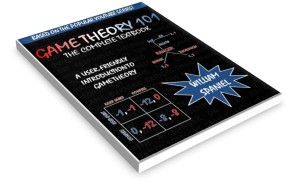Nash equilibrium is the most important solution concept in game theory. We know from last lecture that it is a set of strategies, one for each player, such that no player has incentive to change his or her strategy given what the other players are doing. Stated like this, Nash equilibrium does not have a clear conceptual application.
This is deceiving. In fact, Nash equilibrium has a basic underlying interpretation. We go over it in this lecture.
Takeaway Points
- Another way to think of a Nash equilibrium is as a law that no one would want to break even in the absence of an effective police force.
- Suppose that the police do not exist.
- Imagine that the government passes a law.
- The required behaviors of people that the law outlines is a Nash equilibrium if everyone still wants to abide by it.
- Example: Suppose two cars are sitting perpendicular from each other at a stoplight. The light is green for one of them and red for the other. If the red light car goes, it will cause a crash. If the green light does not go, it is just wasting time. Thus, everyone is happy to follow the law as stated, even if there is no police to ticket the drivers for breaking it. Thus, following the rules of the stoplight is a Nash equilibrium.

